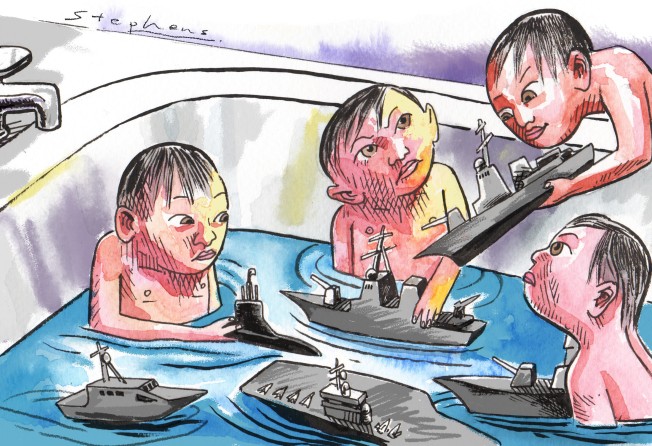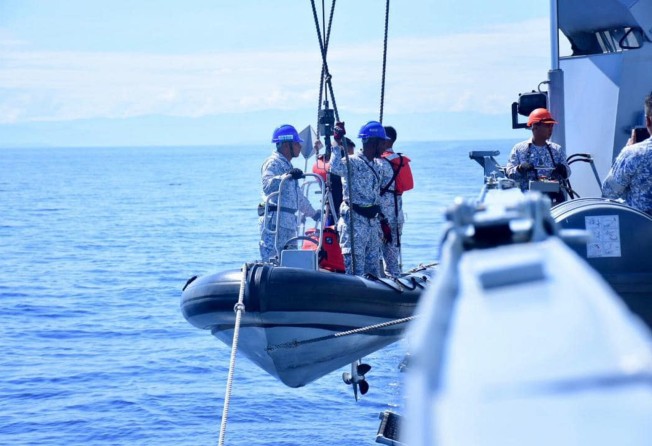
03:10
US submarine strikes unknown underwater object in disputed South China Sea

The Aukus deal that will equip Australia with nuclear-powered submarines may have caught many by surprise. Southeast Asian countries have expressed concern about the development. But they, too, have been shoring up their maritime capabilities in recent years in response to evolving threats.
Even the pandemic is unlikely to reverse this trend and will, at best, only delay some acquisitions. Maintaining regional stability as they upgrade their maritime inventory is crucial.
The momentum to modernise naval and coastguard fleets in Southeast Asia is growing. Countries in the region are reversing years of underinvestment in their seafaring capabilities, decommissioning expensive-to-maintain legacy assets and catching up with neighbours.
Covid-19 has done little to curb the proliferation of maritime threats. Securing choke points like the Strait of Malacca and vital waterways like the South China Sea has become more challenging.
Maritime spats between neighbours are continuing to fester. China’s naval might is growing. US freedom of navigation operations are intensifying. European navies are increasing their forays into the region’s waters.
Great power rivalry, which also plays out in contested maritime spaces, is gathering force. The Aukus alliance between Australia, the United Kingdom and the United States is but the latest addition to this simmering mix.
Countries in the region may reason that beefing up their capabilities is one way to stress their agency in the increasingly complex seascape.
Non-traditional security challenges also persist and are worsening in some cases. Coastal states must contend with the enduring risks of piracy, seaborne transnational crimes, and the movement of criminal and terrorist groups through porous maritime borders.
Foreign illegal fishing, marine environmental damage, and the defence of maritime entitlements demand robust maritime domain awareness and frequent patrols. Stronger typhoons fuelled by climate change require better search and rescue, humanitarian assistance and disaster relief capabilities. All these factors motivate a naval and coastguard build-up among littoral states.
To meet the challenge, Southeast Asian countries have embarked on multi-year modernisation programmes, acquiring new and refurbished surface vessels and submarines. The region already boasts one aircraft carrier operator and five operators of submarines, with another nation on its way to getting a new sub.
On October 22, Malaysia commissioned its third littoral mission ship built by a Chinese company. Last July, Vietnam received its second US decommissioned cutter, which will give its coastguard a big boost.
In March, the Philippines commissioned its second South Korean-built multi-role frigate, with the first one entering service last year. Manila is also due to receive the first three of eight Israeli-made Shaldag fast patrol boats and a multi-role response vessel (MRRV) from Japan by the first quarter of next year with another MRRV due to arrive by May. In 2020, Manila inaugurated a French-built offshore patrol vessel, currently the largest in its coastguard fleet.
Last year, Singapore inducted three locally-built littoral mission vessels, the last of a set of eight Independence-class ships which entered service in 2017. It allowed the country to retire its older Fearless-class vessels.

In 2019, Thailand welcomed a new South Korean-built frigate and a locally-built offshore patrol vessel. It also placed an order for a Chinese-made landing platform dock, while Manila upgraded and activated a decommissioned South Korean corvette.
In 2018, Bangkok fielded five new indigenously-built M-21 coastal patrol ships, while Vietnam received two Russian-made Gepard 3.9 class frigates. In 2017, the Philippines welcomed its second Indonesian-built strategic sealift vessel.
Below the surface, things are also heating up. Last March, Indonesia commissioned its third Nagapasa-class submarine, the first to be built in the region. Last year, Myanmar received a refitted Kilo-class submarine donated by India.
The first of Singapore’s four German-built submarines also underwent sea trials last year and is expected to be delivered this year. In 2018 and 2019, Malaysia refitted its two French-built Perdana Menteri (Scorpene) class submarines.
In 2017, Vietnam commissioned the last two of six Russian-built Kilo-class submarines it ordered back in 2009. In the same year, Thailand concluded a deal for a Chinese Yuan-class S26T submarine, expected to be completed by 2023, but orders for two more have been hobbled by the pandemic and growing public opposition.
The Philippines is also setting its sights on acquiring subsurface capability, but Covid-19 has likewise derailed a possible contract signing.

This flurry of acquisitions shows how regional countries are responding to the challenges of the times, underscoring the idea that, for most nations, diplomacy is one core pillar and defence another.
Leadership changes, public opinion and the pandemic will all present hurdles for defence planners. Structuring deals to get both congressional and public buy-in will be key to moving them forward despite the prevailing tight fiscal space. But the maritime build-up will also demand more astute diplomacy. The two legs have to stand and grow together.
The region’s leaders need to foster a future of comity and stability, not one that will only benefit defence contractors. With more players and more “toys”, the chances of miscalculation will only increase. Hence, as countries invest in developing their militaries, confidence-building, crisis management and security dialogue must be enhanced.
Lucio Blanco Pitlo III is a research fellow at the Asia-Pacific Pathways to Progress Foundation, a fellow at the University of the Philippines Korea Research Centre, and lecturer at the Chinese Studies Programme at Ateneo de Manila University